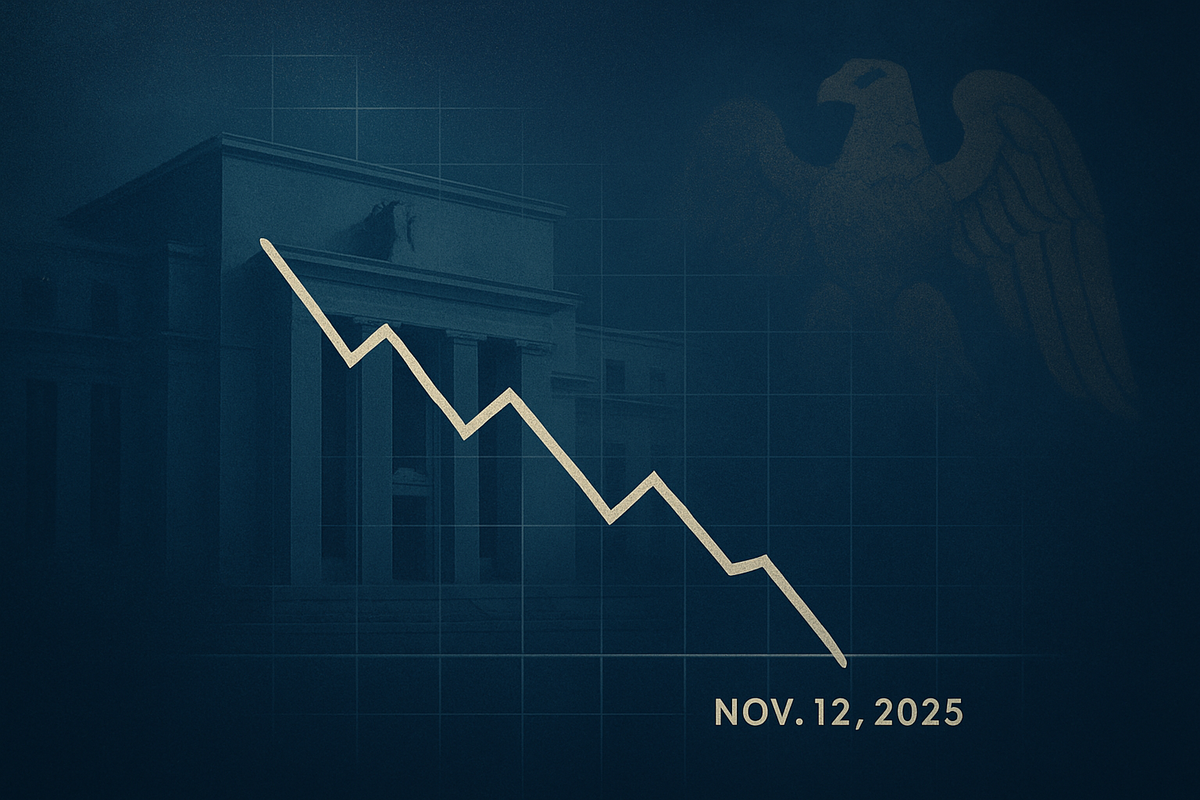
New York, NY – November 12, 2025 – Financial markets today returned from the Veterans Day break with a clear message: the Federal Reserve is increasingly poised for further interest rate cuts. U.S. Treasury yields experienced a notable dip, driven by fresh indications of a weakening labor market and escalating expectations for accelerated monetary easing. This market movement signals a significant shift in investor sentiment and economic outlook, with profound implications for various asset classes moving forward.
The benchmark 10-year U.S. Treasury note's yield eased to approximately 4.08% or 4.09%, representing a decrease of about 0.04 to 0.05 percentage points from the previous trading session. This decline suggests increased demand for Treasury bonds, pushing their prices up and yields down. The market's immediate reaction underscores its hypersensitivity to signals suggesting earlier and more aggressive rate cuts by the Federal Reserve, potentially as early as December 2025.
Detailed Coverage: A Market Responds to Economic Headwinds and Policy Shifts
The primary catalyst for today's Treasury yield decline was the release of weaker-than-expected labor market data. An ADP report, which gained particular attention due to delays in official government data caused by an ongoing shutdown, indicated that private employers were shedding a significant number of jobs in late October, with figures suggesting over 11,000 job cuts per week or a 45,000 decline in October private sector employment, signaling a cooling U.S. labor market and reinforcing the Federal Reserve's incentive to ease monetary policy. This follows previous rate cuts by the Fed in September and October 2025, solidifying a trend towards a more accommodative stance.
The timeline leading up to this moment has been characterized by growing economic caution. Throughout late 2024 and into 2025, concerns about persistent inflation had kept the Federal Reserve on a tightening path. However, by mid-2025, signs of economic deceleration began to emerge, particularly in manufacturing and, more recently, in the labor market. Federal Reserve statements have gradually shifted, with officials acknowledging the need to balance inflation control with maintaining maximum employment. The ongoing U.S. government shutdown has also added a layer of uncertainty, though there was growing optimism today that a resolution might be nearing, with the Senate reportedly passing temporary legislation.
Key players and stakeholders involved in this dynamic include the Federal Reserve, whose monetary policy decisions are paramount; the U.S. Treasury Department, which manages government debt issuance; and major banks (primary dealers) like JPMorgan Chase & Co. (NYSE: JPM) and Bank of America Corporation (NYSE: BAC), which are crucial for market liquidity. Institutional investors, including pension funds and hedge funds, are actively recalibrating their portfolios in response to these shifts.
Initial market reactions were mixed but indicative of the underlying trends. While U.S. stock markets saw gains in the Dow Jones Industrial Average and S&P 500, the Nasdaq Composite experienced a dip, partly attributed to ongoing concerns about the high valuations of AI-driven technology stocks, exemplified by a 3% fall in NVIDIA Corporation (NASDAQ: NVDA) shares following SoftBank's divestment. Gold, often considered a safe-haven asset, saw its prices rise above $4,100 an ounce, driven by the weak U.S. economic data and heightened expectations for Fed rate cuts.
Companies Navigating the Shifting Tides: Winners and Losers
A dip in Treasury yields and the anticipation of Federal Reserve rate cuts, especially amid weak labor market data, signal a more accommodative monetary policy aimed at stimulating economic growth. This environment creates distinct "winners" and "losers" among public companies, driven by changes in borrowing costs, consumer spending, and investor sentiment.
Companies That Might "Win":
- Real Estate and Construction Companies: Lower Treasury yields directly translate to lower mortgage rates, stimulating demand for homes. Homebuilders like D.R. Horton (NYSE: DHI) and Lennar Corporation (NYSE: LEN) could see increased sales. Real Estate Investment Trusts (REITs) also benefit from reduced financing costs.
- Highly Leveraged Businesses and Capital-Intensive Industries: Companies with substantial debt loads see interest payments decrease, improving profitability. Capital-intensive sectors, such as manufacturing, find financing for large projects more affordable. Many small-cap companies, often reliant on floating-rate debt, are particularly sensitive and tend to benefit significantly.
- Technology and Growth Stocks: Lower interest rates reduce the discount rate used to value future earnings, boosting the present valuation of growth companies, especially in tech, which often have anticipated earnings further in the future. Cheaper borrowing also fuels R&D and expansion. Examples include Tesla Inc. (NASDAQ: TSLA) and other high-growth tech firms.
- Consumer Discretionary Companies: Decreased borrowing costs for consumers (mortgages, auto loans) increase disposable income, leading to higher spending on non-essential goods and services. Retailers like Target Corporation (NYSE: TGT) and Walmart Inc. (NYSE: WMT), as well as cruise lines like Royal Caribbean Group (NYSE: RCL), could see a boost.
- Utilities: These capital-intensive companies benefit from lower borrowing costs for infrastructure projects. Their stable, often higher, dividend yields become more attractive to income-focused investors compared to lower bond yields. Examples include Eversource Energy (NYSE: ES) and American Electric Power (NASDAQ: AEP).
Companies That Might "Lose" (or Face Challenges):
- Banks and Financial Institutions: While complex, a general environment of falling interest rates can compress net interest margins (NIM), the difference between interest earned on loans and paid on deposits, potentially reducing profitability for large banks like JPMorgan Chase & Co. (NYSE: JPM). However, regional banks, which struggled with higher rates, might find some relief from reduced default risks.
- Companies with Large Cash Reserves: Companies holding substantial cash benefit from higher interest income when rates are high. As rates decline, this passive income diminishes, representing a relative "loss." Major tech companies like Alphabet Inc. (NASDAQ: GOOGL), Apple Inc. (NASDAQ: AAPL), and Microsoft Corporation (NASDAQ: MSFT), with their massive cash piles, would see a reduction in interest earned, even if their core businesses thrive.
Wider Significance: A Broader Economic Reconfiguration
The dip in Treasury yields on November 12, 2025, driven by weak labor market data and expectations of Fed rate cuts, signals a significant reconfiguration of the economic landscape. This event is symptomatic of several broader industry trends, including a "flight to safety" as investors reallocate capital from riskier assets to government bonds. This particularly benefits defensive sectors like utilities and consumer staples, while cyclical sectors may face headwinds. It also points to a deceleration of economic growth, prompting businesses to focus on cost-cutting and efficiency.
The ripple effects are widespread. Financial institutions, particularly banks, could face net interest margin compression, though lower mortgage rates might stimulate housing activity. Insurance companies, heavily invested in long-term bonds, might struggle to generate adequate returns. Corporations looking to issue or refinance debt will benefit from lower borrowing costs, but overall economic uncertainty might temper new investment. Globally, a significant dip in U.S. Treasury yields can attract foreign capital, potentially strengthening the U.S. dollar, which could make U.S. exports more expensive.
From a regulatory and policy perspective, this scenario reinforces the Federal Reserve's dovish stance, making actual rate cuts more probable. The Fed's primary tools will be further reductions in the federal funds rate and potentially forward guidance signaling sustained low rates. If economic conditions deteriorate significantly, quantitative easing (QE) could be considered. The ongoing government shutdown, if prolonged, could exacerbate market uncertainty and make it harder for the government to respond effectively with fiscal stimulus.
Historically, similar patterns have emerged during periods of economic slowdown. The Dot-Com Bust in the early 2000s, the 2008 Financial Crisis, and even the pre-COVID-19 period in late 2019 saw the Fed cutting rates and Treasury yields plunging as investors sought safety amidst economic turmoil and weak job growth. Today's event fits into this historical pattern, signaling a period of economic caution and significant monetary policy adjustments aimed at stabilizing the economy.
What Comes Next: Navigating the Easing Cycle
The dip in Treasury yields on November 12, 2025, sets the stage for a period of careful observation and strategic maneuvering. In the short-term (late 2025-2026), Treasury yields are expected to continue their downward trend, with the 10-year yield potentially settling around 3.72% by December 2025 if rate cuts proceed. However, longer-term yields might experience upward pressure due to U.S. national debt concerns and persistent inflationary pressures. Equity markets may see continued volatility, with growth stocks likely benefiting from lower discount rates. Fixed income, especially quality medium-duration bonds, is seen as appealing.
Long-term (beyond 2026), a "soft landing" remains a possibility, where economic growth slows but avoids a severe recession. Corporate profits are expected to continue driving equity performance. However, persistent inflation or fiscal concerns could keep rates elevated or lead to a "higher for longer" environment. The expanding U.S. national debt could also exert long-term upward pressure on bond yields.
For companies, strategic pivots will involve aggressive cash flow and debt management, creating new income streams, and strengthening customer and vendor relationships. Maintaining emergency funds and utilizing advanced treasury technology for predictive liquidity performance will be crucial. Investors should consider shifting from cash and short-duration bonds into longer-duration Treasuries and municipal bonds. Reallocating equities towards rate-sensitive sectors like technology and emerging markets, with a focus on quality growth stocks, is advisable. Diversification with alternative income strategies, gold, and potentially Bitcoin can help manage volatility.
Emerging markets (EM) present both opportunities and challenges. Fed rate cuts, particularly those leading to a weaker U.S. dollar, can significantly boost EM equities and debt, making EM assets more attractive and reducing the burden of dollar-denominated debt. However, vulnerable EM countries may still face high borrowing costs, and global trade tensions and geopolitical risks can impact stability.
Potential scenarios include a Soft Landing (base case), where the Fed successfully engineers a gradual rate reduction without a severe recession; a Deeper Recession, if the labor market deteriorates sharply, leading to aggressive rate cuts and underperforming equities; a "Higher for Longer" Rates/Inflation Resurgence scenario if inflation proves stubborn; or Muddled Economic Signals/Persistent Uncertainty, leading to increased market volatility and policy challenges.
Wrap-up: A New Chapter for Market Dynamics
Today's dip in Treasury yields, driven by weak labor data, underscores a pivotal moment in the Federal Reserve's policy trajectory. It solidifies the expectation of a sustained easing cycle, moving from a period of restrictive policy towards a more neutral stance aimed at stimulating economic activity and achieving maximum employment. This shift reflects the Fed's dual mandate, balancing concerns over inflation with a weakening job market.
The lasting impact could be a recalibration of investment strategies across the board. The era of exceptionally high cash yields appears to be drawing to a close, compelling investors to re-evaluate their allocations towards assets that benefit from lower borrowing costs and increased liquidity. This environment generally favors growth-oriented assets and longer-duration fixed income, potentially setting the stage for a prolonged period of different market dynamics than those observed during the recent tightening cycle. The overall economic outlook hinges on whether the Fed can navigate a "soft landing" – bringing down inflation without triggering a severe recession – and the incoming data will be crucial in shaping this narrative.
Investors should remain vigilant and closely monitor several key indicators in the coming months: official labor market reports (once the government shutdown concludes), inflation data for any resurgence, Federal Reserve communications for evolving policy intentions, and the ongoing shape and movements of the yield curve. Corporate earnings, the U.S. fiscal outlook, and broader geopolitical developments will also play crucial roles in shaping the market landscape. By carefully observing these factors, investors can better position their portfolios to navigate the evolving market landscape shaped by the Federal Reserve's anticipated easing cycle and the underlying economic conditions.
This content is intended for informational purposes only and is not financial advice






